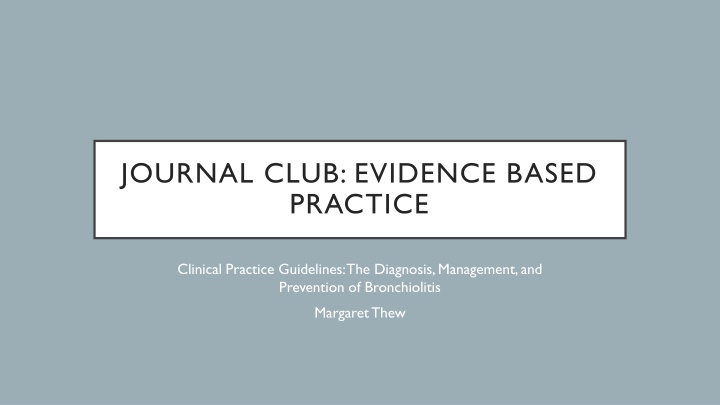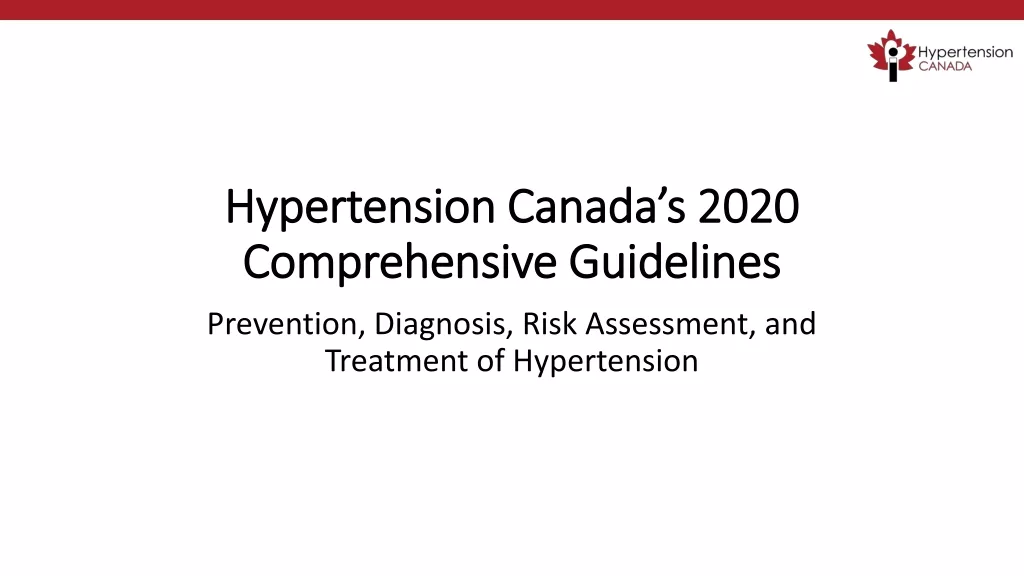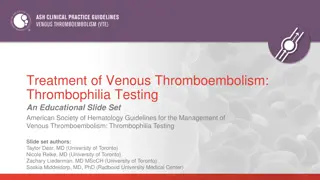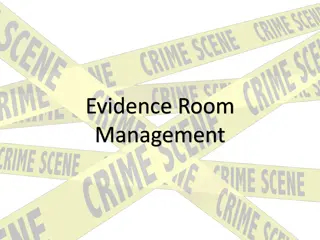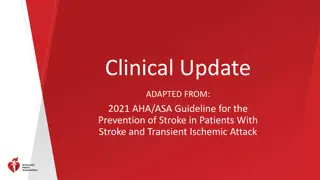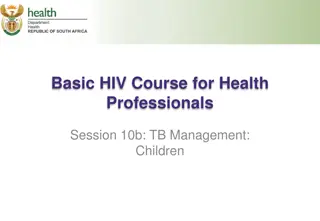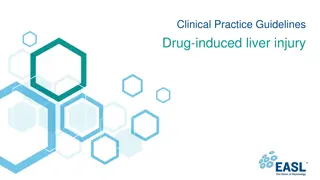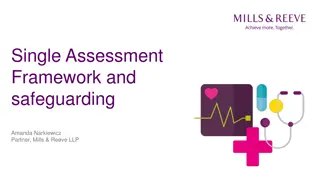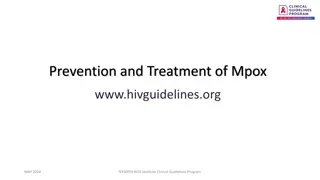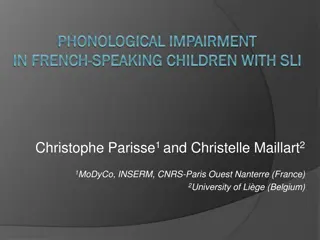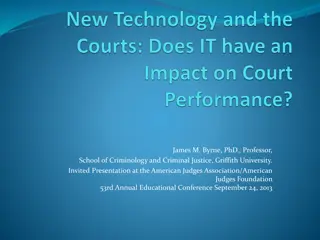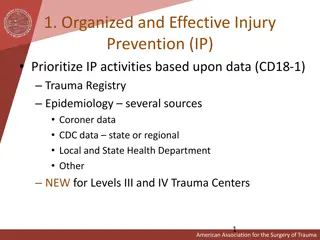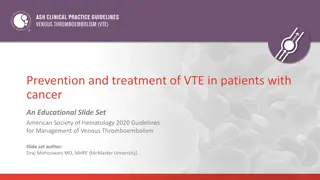Evidence-Based Guidelines for Bronchiolitis in Children: Diagnosis, Management, and Prevention
Bronchiolitis is a common viral illness in infants characterized by lower respiratory tract inflammation. The American Academy of Pediatrics released updated guidelines in 2015 for children aged 1-23 months, focusing on evidence-based approaches for diagnosis, prevention, and management. The guidelines exclude certain populations due to underlying conditions. Bronchiolitis poses a significant risk, leading to high hospitalization rates and substantial costs. A multidisciplinary committee conducted a thorough review of evidence from 2003 to 2014 to develop these guidelines, emphasizing a balance between benefit and harm in their recommendations.
Download Presentation

Please find below an Image/Link to download the presentation.
The content on the website is provided AS IS for your information and personal use only. It may not be sold, licensed, or shared on other websites without obtaining consent from the author.If you encounter any issues during the download, it is possible that the publisher has removed the file from their server.
You are allowed to download the files provided on this website for personal or commercial use, subject to the condition that they are used lawfully. All files are the property of their respective owners.
The content on the website is provided AS IS for your information and personal use only. It may not be sold, licensed, or shared on other websites without obtaining consent from the author.
E N D
Presentation Transcript
JOURNAL CLUB: EVIDENCE BASED PRACTICE Clinical Practice Guidelines: The Diagnosis, Management, and Prevention of Bronchiolitis Margaret Thew
GUIDELINE APPLICATION The bronchiolitis guideline is intended for children from 1-23 months Updated version released 2015 by American Academy of Pediatrics The guideline offers recommendations ranked according to level of evidence and risk/benefit. Key action of this guideline is the use of evidence-based approach to diagnosis, prevention, and management of bronchiolitis
POPULATION Intended for children 1-23 months of age Excluded: Children who are Immunocompromised. Children with underlying respiratory disease. Children with neuromuscular disease. Children with congenital heart disease or known hemodynamic conditions. Recurrent wheezing or risk of asthma.
DEFINITION Bronchiolitis is commonly caused by a viral illness of the lower respiratory tract in infants. It is characterized by acute inflammation, edema, and necrosis of the epithelial cells lining the small airways. There is increased mucous production Signs and Symptoms include; rhinitis, cough which may progress to tachypnea, wheezing, rales, use of accessory muscles, and/or nasal flaring. Peak season December to March Bronchiolitis is the most common cause for hospitalization among infants during the first 12 months.
RISKS Bronchiolitis is the most common cause of hospitalization among infants during their first 12 months of life. ~ 100,000 admissions annually in the United States The estimated cost of these admission is $1.73 billion. One estimate of hospitalization from the CDC was 5.2 per 1000 children < 24 months (study timeline 200-2005) The largest age-specific hospitalization occurred between 30-60 days of age at a rate of 25.9/1000 children.
METHODS A subcommittee was made up of; primary care physicians, pediatricians, family practice, ED, hospital medicine, pulmonologists, neonatal, peds infectious disease, a parent representative, and an epidemiologist trained in systemic reviews. The evidence search and review included electronic database searches in The Cochrane Library, Ovid, CINAHL, EBSCO and Pubmed. The search strategy included database searches reviewed by 1 of 4 members of the committee. The original evidence-based articles from 2003 were reviewed along with new evidence-based articles written from 2004 2014.
EVIDENCE-BASED APPROACH The evidence-based approach reflect the quality of evidence and the balance of benefit and harm that is anticipated when the recommendation is followed. This clinical practice guideline is not intended as a sole source of guidance in management of children with bronchiolitis only as a guide to support decision making. These guidelines are reviewed every 5 years.
LEVELS OF RECOMMENDATION
Aggregate evidence quality B Benefits Inexpensive, noninvasive, accurate Risk, harm, cost Missing other diagnoses DIAGNOSIS Benefit-harm assessment Benefits outweigh harms Value judgments None This is 1A (strongly recommended Intentional vagueness None Evidence Quality: B; Recommendation Strength: Strong Recommendation). Role of patient preferences None Exclusions None Strength Strong recommendation Differences of opinion None
aggregate evidence quality B Improved ability to predict course of illness, appropriate disposition Benefits Possible unnecessary hospitalization parental anxiety Risk, harm, cost ASSESS RISK Benefit-harm assessment Value judgments Intentional vagueness Role of patient preferences Exclusions Strength Differences of opinion Benefits outweigh harms None Assess is not defined None None Moderate recommendation None This is 1B: Moderate recommendation Evidence Quality: B; Recommendation Strength: Moderate Recommendation
Aggregate evidence quality B DIAGNOSIS BASED ON HISTORY AND PHYSICAL EXAM Decreased radiation exposure, noninvasive (less procedure-associated discomfort), decreased antibiotic use, cost savings, time saving Misdiagnosis, missed diagnosis of comorbid condition Benefits outweigh harms None None Benefits Evidence Quality: B; Recommendation Strength: Moderate Recommendation Risk, harm, cost Benefit-harm assessment Value judgments Intentional vagueness Role of patient preferences None Infants and children with unexpected worsening disease Moderate recommendation None Exclusions Strength Differences of opinion
Aggregate evidence quality B Avoid adverse effects, avoid ongoing use of ineffective medication, lower cost Missing transient benefit of drug Benefits out weight harms Overall ineffectiveness out weights possible transient benefit None None None Strong recommendations None This guideline no longer recommends a trail of albuterol as was previously considered Benefits ALBUTEROL Risk, harm, cost Benefit-harm assessment Quality: B; Recommendation Strength: Strong Recommendation value judgement intentional vagueness Role of patient preference Exclusions Strength Difference of opinion Notes
Aggregate evidence quality B Avoiding adverse effects, lower costs, avoiding ongoing use of ineffective medications Benefits Risk, harm, cost EPINEPHRINE Missing transient benefit of drug Benefit-harm assessment Benefit outweighs harm The overall ineffectiveness outweights possible transient benefits None None Rescue treatment of rapidly deteriorating patients Strong recommendation None value judgement Evidence Quality: B; Recommendation Strength: Strong Recommendation intentional vagueness Role of patient preference Exclusions Strength Difference of opionion
Aggregate evidence quality B Avoiding adverse effects, such as wheezing and excess secretions, cost None Benefit outweighs Harm None None None None Benefits Risk, harm, cost Benefit-harm assessment Value Judgement Intentional Vagueness Role of patient preference Exclusions HYPERTONIC SALINE Evidence Quality: B; Recommendation Strength: Moderate Recommendation Strength Moderate Recommendation Difference of opionion None
Aggregate evidence quality A CORTICOSTEROIDS No clinical benefit, avoiding adverse effects None Benefits Risk, harm, cost Quality: A; Recommendation Strength: Strong Recommendation Benefit-harm assessment Benefit outweighs Harm Value Judgement Intentional Vagueness None None Role of patient preference None Exclusions Strength None Strong Recommendation None Difference of opionion
Benefits Decreased hospitalizations, decreased length of Stay Hypoxemia, physiologic stress, prolonged length of stay, increased hospitalizations, increased length of stay, cost OXYGEN Risk, harm, cost Benefit-harm assessment Benefit outweighs Harm Oxyhemoglobin saturation >89% is adequate to oxygenate tissues; the risk of hypoxemia with oxyhemoglobin saturation >89% is minimal Evidence Quality: D; Recommendation Strength: Weak Recommendation based on low-level evidence and reasoning from first principles Value Judgement Intentional Vagueness None Role of patient preference Limited Exclusions Children with acidosis or fever Weak recommendation (based on low-level evidence/ reasoning from first principles) Strength Difference of opionion None
Aggregate evidence quality C Shorter length of stay, decreased alarm fatigue, decreased cost Benefits CONTINUOUS PULSE OXIMETRY Delayed detection of hypoxemia. Depay in appropriate weaning of oxygen Risk, harm, cost Evidence Quality: C; Recommendation Strength: Weak Recommendation based on lower level evidence. Benefits outweigh harms Risk, harm assessment Value judgments None Intentional vagueness None Role of patient preferences Limited Exclusions None Weak recommendation (based on lower level of evidence) Strength Differences of opinion None
Aggregate evidence quality B Decreased stress from therapy, reduced cost Benefits CHEST PHYSIOTHERAPY Risk, harm, assessment Benefits out weight harms Benefit-harm cost Value judgments None None Evidence Quality: B; Recommendation Strength: Moderate Recommendation. Intentional vagueness None Role of patient preferences None Exclusions Strength None Moderate Recommendation Differences of opinion None
Evidence Quality: B; Recommendation Strength: Strong Recommendation Aggregate evidence quality B Fewer adverse effects, less resistance to antibacterial agents, lower cost None Benefits Risk, harm, cost Benefit-harm assessment Value judgments ANTIBIOTIC USE Benefits outweigh harms None Strong suspicion is not specifically defined and requires clinician judgment. An evaluation for the source of possible serious bacterial infection should be completed before antibiotic use Intentional vagueness Role of patient preferences Exclusions Strength Differences of opinion None None Strong Recommendations None
Aggregate evidence quality X Benefits Maintaining hydration FLUIDS Risk of infection, risk of aspiration with nasogastric tube, discomfort, hyponatremia, IV infiltration, over hydration Risk, harm, cost Evidence Quality: X; Recommendation Strength: Strong Recommendation. Benefit-harm assessment Benefits outweigh harms Value judgments None Intentional vagueness None Shared decision as to which mode is used Role of patient preferences Exclusions None Strength Strong Recommendations Differences of opinion None
PALIVIZUMAB Evidence Quality: B; Recommendation Strength: Strong Recommendation. No evidence suggests palivizumab is a cost- effective measure to prevent recurrent wheezing in children. Prophylaxis should not be administered to reduce recurrent wheezing in later years.
Evidence Quality: B; Recommendation Strength: Strong Recommendation Aggregate evidence quality B Benefits Decreased transmission of disease Risk, harm, cost Possible hand irritation Benefit-harm assessment Benefits outweigh the harms HAND HYGIENE Value judgments None Intentional vagueness None Role of patient preferences None Exclusions None Strength Strong Recommendations Differences of opinion None
Aggregate evidence quality Benefits B ALCOHOL-BASED DECONTAMINATION Less hand irritation If there is visible dirt on the hands, hand washing is necessary. Alcohol-based rubs are not effective for C. Difficile, present a fire harzard, and have a slight increased cost Benefits outweigh the harms None None None None Strong Recommendations None Risk, harm, cost Evidence Quality: B; Recommendation Strength: Strong Recommendation Benefit-harm assessment Value judgments Intentional vagueness Role of patient preferences Exclusions Strength Differences of opinion
Aggregate evidence quality C Can identify infants and children at risk whose family may benefit from counseling, predicting risk of severe disease Time to inquire Benefits outweigh the harms None None Parents may choose to deny tobacco use even though they are, in fact users None Moderate Recommendations None Benefits SMOKING Risk, harm, cost Evidence Quality: C; Recommendation Strength: Moderate Recommendation Benefit-harm assessment Value judgments Intentional vagueness Role of patient preferences Exclusions Strength Differences of opinion
Aggregate evidence quality B COUNSELING ON ENVIRONMENTAL Reinforce the detrimental effects of smoking, potential to decrease smoking Time to counsel Benefits outweigh the harms None None Parents may choose to ignore counseling None Moderate Recommendations None Counseling for tobacco smoke prevention should begin in the prenatal period and continue in family-centered care and at all well-infant visits Benefits Risk, harm, cost Benefit-harm assessment Value judgments Intentional vagueness Evidence Quality: B; Recommendation Strength: Strong Recommendation Role of patient preferences Exclusions Strength Differences of opinion Notes
Aggregate evidence quality B May reduce the risk of bronchiolitis and other illnesses; multiple benefits of breastfeeding unrelated to bronchiolitis Benefits Risk, harm, cost None BREASTFEEDING Benefit-harm assessment Value judgments Intentional vagueness Role of patient preferences Exclusions Strength Benefits outweigh harms None None Parents may choose to feed formula rather than breastfeed None Moderate Recommendations Education on breastfeeding should begin in the prenatal period Evidence Quality: Grade B; Recommendation Strength: Moderate Recommendation Differences of opinion
Aggregate evidence quality C Decrease transmission of disease, benefits of breastfeeding promotion of judicious use of antibiotics, risks of infant lung damage attributable to tobacco smoke Benefits FAMILY EDUCATION Risk, harm, cost Time to educate properly Benefit-harm assessment Benefits outweigh harms Value judgments None Evidence Quality: C; observational studies; Recommendation Strength; Moderate Recommendation Personnel is not speifically defined but should include all people who enter a patient's room Intentional vagueness Role of patient preferences Exclusions None None Strength Moderate Recommendations Differences of opinion None
Better algorithms for predicting the course of illness Impact of clinical score on patient outcomes Evaluating different ethnic groups and varying response to treatments Does epinephrine alone reduce admission in outpatient settings? FUTURE RESEARCH NEEDS Additional studies on epinephrine in combination with dexamethasone or other corticosteroids Hypertonic saline studies in the outpatient setting and in in hospitals with shorter LOS More studies on nasogastric hydration More studies on tonicity of intravenous fluids
Incidence of true AOM in bronchiolitis by using 2013 guideline definition More studies on deep suctioning and nasopharyngeal suctioning Strategies for monitoring oxygen saturation Use of home oxygen FUTURE RESEARCH NEEDS Appropriate cutoff for use of oxygen in high altitude Oxygen delivered by high-flow nasal cannula RSV vaccine and antiviral agents Use of palivizumab in special populations, such as cystic fibrosis, neuromuscular diseases, Down syndrome, immune deficiency Emphasis on parent satisfaction/ patient-centered outcomes in all research (ie, not LOS as the only measure)
REFERENCE Ralston, S. L., Lieberthal, A. S., Meissner, C., Alverson, J.E., Baley, J.E., Gadomski,A. m., Johnson, D. W., Light, M.J., Maraqa, N. F., Mendonca, E.A., Phelan, K.J., Zorc, J.J., Stanko- Lopp, D., Brown, M.A., Nathanson, I., Rosenblum,E., Sayles, S., and Hernandez-Cancio, S. (2014). Clinical practice guideline: The diagnosis, management, and prevention of bronchiolitis. Pediatrics. 134. e1474-1501.
